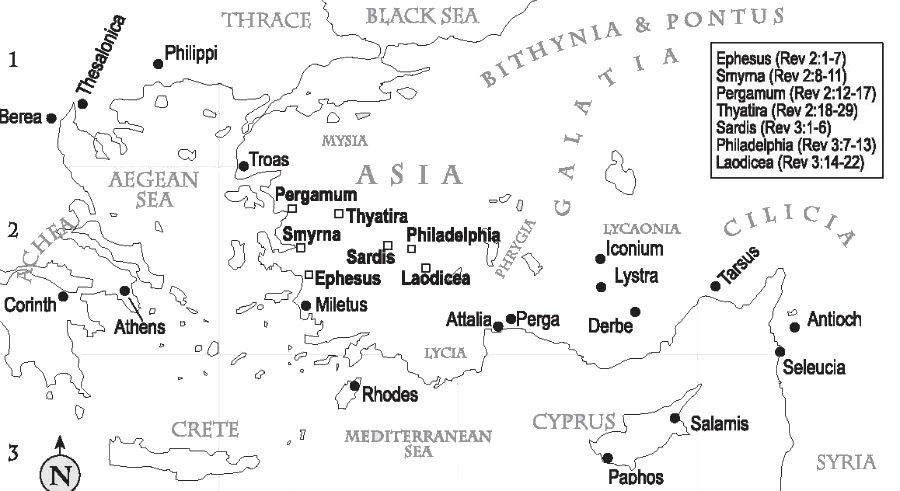The Seven Churches of Revelation
- Ephesus: Revelation 1:11; 2:1-7; Acts 18:19-28; 19:1-41;
- Ephesians Smyrna : Revelation 2:8-11
- Pergamon : Revelation 2:12-17
- Thyatira: Revelation 2:18-29; Acts 16:14
- Sardis : Revelation 3:1-6
- Philadelphia: Revelation 3:7-13
- Laodicea : Revelation 3:14-22; Colossians 2:1; 4:13-16
The Seven Churches mentioned in The Revelation of Apostle John have long held a unique place among the sites to be visited in Asia Minor. It is generally thought that these seven were more a symbolic idea than a limited number needing immediate encouragement and admonition. But the impress of the apocalyptic message has given these particular churches qualities of both obscurity and importance which theologians are still struggling to interpret.
The places are well-known; all are close to Izmir and can be reached easily by public or private transportation. It is possible that the cities are named in the order of a regular circuit made by a messenger for the churches. Each is within a two or three day trip of the one before by horseback, given good travelling conditions; the longest stretch is the last leg between Laodicea and Ephesus. The seven could be visited in the order they are addressed without much retracing of one’s steps.
Three are still living cities: Smyrna (Izmir), Philadelphia (Alasehir), and Thyatira (Akhisar). Bergama Is just to the side of Pergamon, Goncali is below the hills of Laodicea, and the village of Sartmustafa is close to Sardis. Three, Ephesus, Thyatira, and Laodicea, are mentioned elsewhere in the New Testament. Of the seven, Ephesus gives the visitor today the fullest sense of a complex, bustling metropolis at the turn of the Christian area. All have been studied by archeologists, but today active excavations are not being carried on in Smyrna or Philadelphia. The work in the others varies according to funds and scholars available, possibility of important finds, complications with buildings currently in use on the sites, and many similar problems. Philadelphia and Thyatira show little of their Roman oackgrounds; most of the building stones that may have made churches or theaters have been used so often for other purposes in the places that have been inhabited recently that their original identifying character has worn off or been defaced.
In the Roman Empire at certain periods of the first century all citizens were required to worship past and present emperors and also Roma, the female personification of Rome. Since most of the earliest Christians had been Jews and since Jews were exempt from bowing to Roman gods, these first Christians were also exempt. But as Christianity spread among the Gentiles, most Christians by the end of that century were not Jews. The religion of Jesus by then had become separate from Judaism. As pressure on the followers of Jesus to worship the Roman gods increased, more and more Christians were unable to bear the persecution and so fell away from their faith. Because of this the best evidence for the date of the writing of Revelation points to the last year or two of the reign of Domitlan (81-96 AD.) when persecution both in Rome and in the eastern provinces was not infrequent.
The author of Revelation, John, seems to have written expecting his work to be read aloud, not only in the seven churches he addressed but also throughout the area. He intended to be understood by the congregations as he also seems to have understood details in each of their backgrounds: the gleaming sun god of Thyatira, the famous ointment of Laodicea. His purpose was to prevent the disintegration of Christianity by clarifying and sharpening the alternatives facing Christians then: the choices of worshipping Caesar or God. It is possible that he intentionally used the apocalyptic form of literature because he believed that that would be the most persuasive for his audience. He promised that, although the powers of evil are now in control of human affairs, God will intervene and overcome them to the glory of His name and the salvation of the faithful. John wished to make Christian martydom surpassingly attractive and the eternal punishment of paganism or apostacism irrefutable. For many people then, and even today, he succeeded.
Seven Churches of Revelation,
